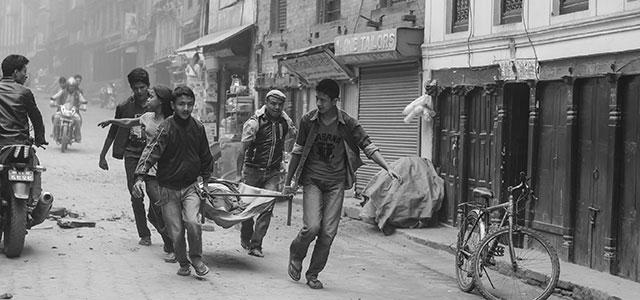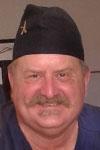
Bhaktapur, Nepal, residents carry a person to the hospital who was injured in the April 2015 earthquake (photo by CCeliaPhoto).
Learning and Teaching the Nursing Lessons of the Nepal Earthquake
On April 25, 2015, Joe Niemczura (MS ’81) was in his room in Bhairawaha, Nepal, when his desk started moving and the water in his glass began to roll.
 Joe Niemczura “I knew immediately it was an earthquake, because I had been through a bunch in San Francisco,” he says. Given that he was about 200 miles from the quake’s epicenter, Niemczura was not surprised to learn later that the quake registered 7.8 on the Richter scale and would eventually inflict a death toll of more than 8,900 people while injuring more than 23,000.
Joe Niemczura “I knew immediately it was an earthquake, because I had been through a bunch in San Francisco,” he says. Given that he was about 200 miles from the quake’s epicenter, Niemczura was not surprised to learn later that the quake registered 7.8 on the Richter scale and would eventually inflict a death toll of more than 8,900 people while injuring more than 23,000.
Yet he takes some solace in believing the toll might have been worse had he not, in 2011, created a one-man nongovernmental organization (NGO) to train Nepalese nurses and physicians in advanced cardiac life support skills.
In the ensuing years, he has taught his course 68 times at nursing and medical schools throughout Nepal, training some 2,100 clinicians. “On the day of the quake, there were about 800 people in Katmandu Valley who had taken my course,” says Niemczura, who had spent most of the past year in Nepal while on leave from a teaching position in the US.
On his blog, he posted a Facebook message he received from one of the people he had trained:
I was in thamel when the 11:56 happened. A 5 storeyed building. Glad it didnt give up. I survived. Came outside to see 2 houses collapsed. We dug out 2 people, husband and wife with local resources [like] shovel. The emergency protocols came spontaneously to me. I was able to stabilize them both physically and psychologically. Then in the late afternoon, I went to Bir hospital NAMS to see if i could contribute as a medical student. I performed half a dozen CPRs and assisted in many other emergency management. Could not save them all though. Saddened me of course. Wanted you to know all this because it is all thanks to you and your teaching approach that everything came to me spontaneously. You did save a lot of lives from dharahara quake through me. Thank you.
“It moved me to tears,” says Niemczura, who in 2014 authored a book about his time in Nepal titled The Sacrament of the Goddess.
How He Got There
Niemczura’s path to Nepal was somewhat serendipitous. Having spent most of his career splitting time between teaching and practicing in adult critical care, in 2007 he decided to spend his summer break in Nepal.
“I’m a nurse, I believe in service to humanity, I like to keep busy, and I was fascinated by South Asian culture,” he says.
Between 2007 and 2014, he returned to Nepal five times, adapting an advanced cardiac life support course that is commonly taught in the US because in Nepal, most medical and nursing education doesn’t involve training in emergent procedures, says Niemczura.
Eventually, he created his NGO and became a traveling educator at multiple nursing and medical schools throughout the country. “I think I have people who have taken my course who work in every ICU and ER in Katmandu,” he says.
Applying the Lessons
On his blog – where the number of hits soared from about 100 to 800 a day in the quake’s aftermath – Niemczura gives specific advice for nurses and physicians who want to volunteer in Nepal. Yet he warns, “Doing hospital work in a place like this takes a lot of preparation – and if you haven’t done this type of work before, you would have made more impact by just sending money. But now that the initial aftershocks are lessening, it’s still a fascinating place to visit – as a tourist first.”
He is pleased, however, that his students were prepared. “In my classes, I joke about how in emergency situations we have to become zombies – overcome the shock of an emergency and just apply what we know automatically, so when my student wrote saying that’s what happened, well, it’s what any teacher wants to hear.”
It was especially gratifying, he says, because in Nepal there’s a culture of waiting for permission from an elder or superior before acting.
“For a professional person [like a nurse], that mind-set is a problem,” says Niemczura. “If you survive a disaster, you are going to have to be ready to use your skills.… Every nurse, no matter what their clinical practice is or where they live, has to realize the job they have in society. That’s the lesson. There’s no international person who is going to come to any area soon enough, so the people who are there have to be ready to do what they do.”



